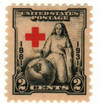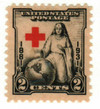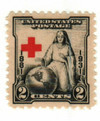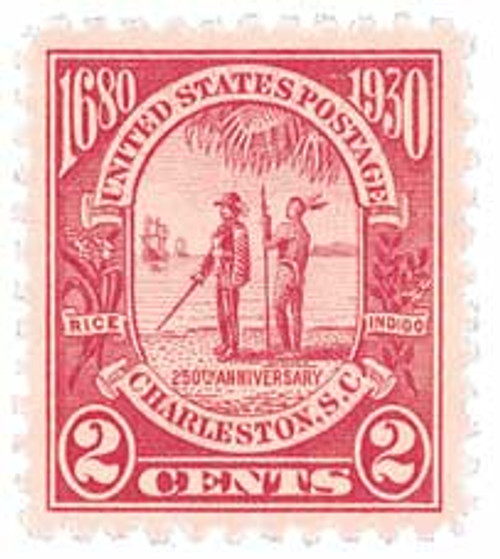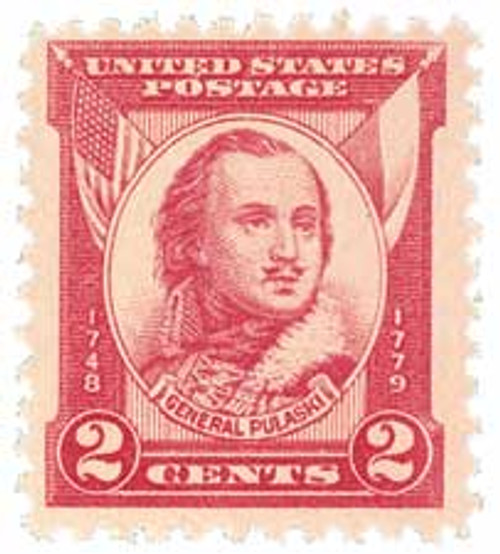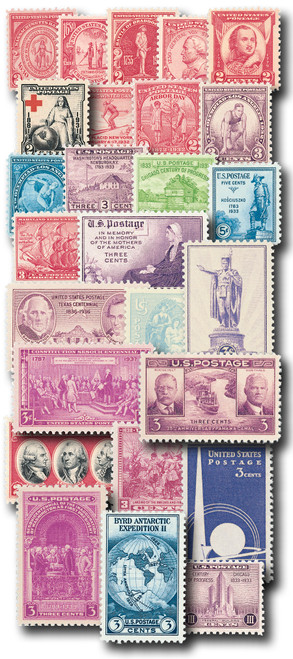
# 702 - 1931 2c Red Cross Issue
Clara Barton's work on the battlefields during the Civil War, and then behind the lines during the Franco-Prussian War, led to the establishment of the American Red Cross. This issue commemorates the 50th anniversary of the founding of the American Red Cross.
Birth Of American Red Cross
Clara Barton was born on December 25, 1821 in North Oxford, Massachusetts. She was a bright child that excelled in school. When she was 10, she committed herself to nursing her brother back to health after he fell off the roof of barn. Even though the doctors eventually believed he was beyond healing, she was dedicated to helping him and he made a full recovery.
A shy child, Barton’s parents convinced her to become a teacher and she earned her first teacher’s certificate at the age of 17. Teaching proved to bring her out of her shell, giving her the confidence to demand equal pay.

For 18 years Clara Barton worked as a teacher, and then as a Patent Office clerk in Washington. D.C. At the outbreak of the Civil War, however, she was one of the first volunteers to provide nursing care for the Union wounded. After the First Battle of Bull Run in July 1861, she began advertising in newspapers for medical supplies, and received such enormous quantities that she soon established her own distribution center.
By August 1862, she had obtained the surgeon general’s permission to work in the front lines. In 1863, she carried her work to Charleston during siege operations there, and then went on to Fredericksburg for Grant’s Wilderness and Spotsylvania campaigns in 1864. A familiar figure in Union camps and field hospitals, she soon earned the title “the angel of the battlefield.” On one occasion, she narrowly avoided a bullet that tore through her dress, though it killed the man she was caring for.

After the Civil War Barton found that there were thousands of unanswered letters at the War Department from relatives asking about fallen soldiers that were buried in unmarked graves. Barton wanted to help give the families comfort, so she opened the Office of Missing Soldiers to find and identify soldiers killed or missing in action. She and her assistants then wrote over 41,800 replies and located more than 22,000 missing men. They also found, identified, and buried 33,000 fallen soldiers.

In the coming years, Barton traveled the country giving lectures on her wartime experiences. By 1868 she was exhausted and given doctors orders to take a trip to relax. Baron decided to go to Europe, where she’d find a new calling.
In 1869 Barton visited Geneva, Switzerland and learned about the International Red Cross and its founders’ interest in forming similar relief societies around the world. The following year when the Franco-Prussian War broke out, Barton assisted in the creation of military hospitals and worked with the Red Cross. She was placed in charge of distributing supplies to the people of Paris and received the Golden Cross of Baden and the Prussian Iron Cross at the war’s end.
Barton returned to America in 1873 and resolved to establish an American Red Cross. Five years later she met with President Rutherford B. Hayes on the issue. However, he didn’t see the necessity in such an organization, as he believed America would never be involved in another engagement like the Civil War again. She later had better luck convincing Chester Arthur of the need for Red Cross, explaining that it could respond to other crises such as natural disasters.
On May 21, 1881, Barton held the first meeting of the American National Red Cross at her home in Washington, D.C. She eventually gained the support of John D. Rockefeller, four other businessmen, and the federal government, which all donated money to establish the national headquarters near the White House.

The American Red Cross had its first opportunity to provide major relief in September 1881 when a massive fire left 5,000 people in Michigan homeless. Barton often took charge of major disasters, but she was eventually forced out of that role so professional social work experts could provide more efficient aid.
Clara Barton's work on the battlefields during the Civil War, and then behind the lines during the Franco-Prussian War, led to the establishment of the American Red Cross. This issue commemorates the 50th anniversary of the founding of the American Red Cross.
Birth Of American Red Cross
Clara Barton was born on December 25, 1821 in North Oxford, Massachusetts. She was a bright child that excelled in school. When she was 10, she committed herself to nursing her brother back to health after he fell off the roof of barn. Even though the doctors eventually believed he was beyond healing, she was dedicated to helping him and he made a full recovery.
A shy child, Barton’s parents convinced her to become a teacher and she earned her first teacher’s certificate at the age of 17. Teaching proved to bring her out of her shell, giving her the confidence to demand equal pay.

For 18 years Clara Barton worked as a teacher, and then as a Patent Office clerk in Washington. D.C. At the outbreak of the Civil War, however, she was one of the first volunteers to provide nursing care for the Union wounded. After the First Battle of Bull Run in July 1861, she began advertising in newspapers for medical supplies, and received such enormous quantities that she soon established her own distribution center.
By August 1862, she had obtained the surgeon general’s permission to work in the front lines. In 1863, she carried her work to Charleston during siege operations there, and then went on to Fredericksburg for Grant’s Wilderness and Spotsylvania campaigns in 1864. A familiar figure in Union camps and field hospitals, she soon earned the title “the angel of the battlefield.” On one occasion, she narrowly avoided a bullet that tore through her dress, though it killed the man she was caring for.

After the Civil War Barton found that there were thousands of unanswered letters at the War Department from relatives asking about fallen soldiers that were buried in unmarked graves. Barton wanted to help give the families comfort, so she opened the Office of Missing Soldiers to find and identify soldiers killed or missing in action. She and her assistants then wrote over 41,800 replies and located more than 22,000 missing men. They also found, identified, and buried 33,000 fallen soldiers.

In the coming years, Barton traveled the country giving lectures on her wartime experiences. By 1868 she was exhausted and given doctors orders to take a trip to relax. Baron decided to go to Europe, where she’d find a new calling.
In 1869 Barton visited Geneva, Switzerland and learned about the International Red Cross and its founders’ interest in forming similar relief societies around the world. The following year when the Franco-Prussian War broke out, Barton assisted in the creation of military hospitals and worked with the Red Cross. She was placed in charge of distributing supplies to the people of Paris and received the Golden Cross of Baden and the Prussian Iron Cross at the war’s end.
Barton returned to America in 1873 and resolved to establish an American Red Cross. Five years later she met with President Rutherford B. Hayes on the issue. However, he didn’t see the necessity in such an organization, as he believed America would never be involved in another engagement like the Civil War again. She later had better luck convincing Chester Arthur of the need for Red Cross, explaining that it could respond to other crises such as natural disasters.
On May 21, 1881, Barton held the first meeting of the American National Red Cross at her home in Washington, D.C. She eventually gained the support of John D. Rockefeller, four other businessmen, and the federal government, which all donated money to establish the national headquarters near the White House.

The American Red Cross had its first opportunity to provide major relief in September 1881 when a massive fire left 5,000 people in Michigan homeless. Barton often took charge of major disasters, but she was eventually forced out of that role so professional social work experts could provide more efficient aid.





